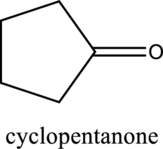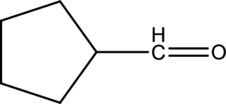
Concept explainers
a.
The product formed when the below aldehyde reacts with Tollens reagent has to be determined.

Concept introduction:
Oxidation of aldehyde:
b.
Interpretation:
The product forms when the below ketone reacts with Tollens reagent has to be determined.

Concept introduction:
Refer to part ‘a.’.
c.
Interpretation:
The product forms when the below aldehyde reacts with Tollens reagent has to be determined.

Concept introduction:
Refer to part ‘a.’.
d.
Interpretation:
The product forms when the below alcohol reacts with Tollens reagent has to be determined.

Concept introduction:
Refer to part ‘a.’.
Want to see the full answer?
Check out a sample textbook solution
Chapter 12 Solutions
Connect 1-Semester Online Access for Principles of General, Organic & Biochemistry
- What is the major organic product of the following nucleophilic acyl substitution reaction of an acid chloride below?arrow_forwardWould the following organic synthesis occur in one step? Add any missing products, required catalysts, inorganic reagents, and other important conditions. Please include a detailed explanation and drawings showing how the reaction may occur in one step.arrow_forwardIf a reaction occurs, what would be the major products? Please include a detailed explanation as well as a drawing showing how the reaction occurs and what the final product is.arrow_forward
- Please help me answer the following questions using the data I included. 1&2arrow_forwardAssign all the Protons in HNMRarrow_forwardProvide the missing information HO NO2 Br2 FeBr3 to CI HO H₂N NO2 AICI3 Zn(Hg), HCI 1. NBS 2. t-BuONa 1. Br₂, FeBr3 2. CH3CI, AC13 3. Na2Cr2O7 Br NH2 SO3H HO H₂N Brarrow_forward
- If we have the equation 3 ln0 = 2t. What is the value of t?arrow_forward1 N2H4 (l) + 3 O2(g) > 2 NO2 (g) + 2 H2O (g) If 75.0 kg of hydrazine are reacted with 75.0 kg of oxygen, which is the limiting reactant?arrow_forwardPQ-10. What is the major product of this reaction? (A) (C) 930 Me HO O=S=O O-8-CF, C 어 Me H+ OH 270 O 0-5-0 O=S=O O-S-CF CF3 2arrow_forward
 General Chemistry - Standalone book (MindTap Cour...ChemistryISBN:9781305580343Author:Steven D. Gammon, Ebbing, Darrell Ebbing, Steven D., Darrell; Gammon, Darrell Ebbing; Steven D. Gammon, Darrell D.; Gammon, Ebbing; Steven D. Gammon; DarrellPublisher:Cengage Learning
General Chemistry - Standalone book (MindTap Cour...ChemistryISBN:9781305580343Author:Steven D. Gammon, Ebbing, Darrell Ebbing, Steven D., Darrell; Gammon, Darrell Ebbing; Steven D. Gammon, Darrell D.; Gammon, Ebbing; Steven D. Gammon; DarrellPublisher:Cengage Learning

 Chemistry for Today: General, Organic, and Bioche...ChemistryISBN:9781305960060Author:Spencer L. Seager, Michael R. Slabaugh, Maren S. HansenPublisher:Cengage Learning
Chemistry for Today: General, Organic, and Bioche...ChemistryISBN:9781305960060Author:Spencer L. Seager, Michael R. Slabaugh, Maren S. HansenPublisher:Cengage Learning ChemistryChemistryISBN:9781305957404Author:Steven S. Zumdahl, Susan A. Zumdahl, Donald J. DeCostePublisher:Cengage Learning
ChemistryChemistryISBN:9781305957404Author:Steven S. Zumdahl, Susan A. Zumdahl, Donald J. DeCostePublisher:Cengage Learning Chemistry: An Atoms First ApproachChemistryISBN:9781305079243Author:Steven S. Zumdahl, Susan A. ZumdahlPublisher:Cengage Learning
Chemistry: An Atoms First ApproachChemistryISBN:9781305079243Author:Steven S. Zumdahl, Susan A. ZumdahlPublisher:Cengage Learning





